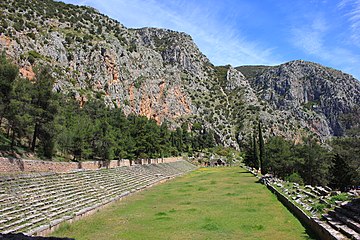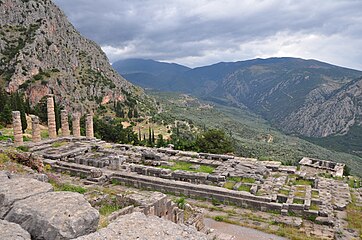
Delphi, in legend previously called Pytho (Πυθώ), in ancient times was a sacred precinct that served as the seat of Pythia, the major oracle who was consulted about important decisions throughout the ancient classical world. The oracle was international in character and also fostered sentiments of Greek nationality, even though the nation of Greece was centuries away from realization. The ancient Greeks considered the centre of the world to be in Delphi, marked by the stone monument known as the omphalos (navel). The sacred precinct was in the region of Phocis, but its management had been taken away from the Phocians, who were trying to extort money from its visitors, and had been placed in the hands of an amphictyony, or committee of persons chosen mainly from Central Greece. According to the Suda, Delphi took its name from the Delphyne, the she-serpent (drakaina) who lived there and was killed by the god Apollo.
Polygnotus was an ancient Greek painter from the middle of the 5th century BC.

Lycosura was a city in the ancient Parrhasia region of south Arcadia said by Pausanias to be the oldest city in the world, although there is no evidence for its existence before the fourth century BCE. Its current significance is chiefly associated with the sanctuary of the goddess Despoina, which contained a colossal sculptural group that Pausanias wrote was made by Damophon of Messene. This group comprises acrolithic-technique statues of Despoina and Demeter seated on a throne, with statues of Artemis and the Titan Anytos standing on either side of them – all in Pentelic marble. The dates of both the temple and the sculptural group have occasioned some dispute. Remains of a stoa, altars, and other structures have been found at the site as well. The Sanctuary of Despoina at Lycosoura is located 9 km WSW of Megalopolis, 6.9 km SSE of Mount Lykaion, and 160 km SW of Athens. There is a small museum at the archaeological site housing small finds as well as part of the cult group, while the remains of the cult statues of Despoina and Demeter are displayed at the National Archaeological Museum of Athens.

The Stoa of the Athenians is an ancient portico in the Delphic Sanctuary, Greece, located south of the Temple of Apollo. The southern side of the polygonal wall of the platform forms the north wall of the stoa. It was constructed c. 478 BC-470 BC during the early Classical period. The one-aisled stoa with Ionic colonnade opens toward the southeast. It was dedicated by the Athenians after the Persian Wars.

Delphi Archaeological museum is one of the principal museums of Greece and one of the most visited. It is operated by the Greek Ministry of Culture. Founded in 1903, it has been rearranged several times and houses the discoveries made at the Panhellenic sanctuary of Delphi, which date from the Late Helladic (Mycenean) period to the early Byzantine era.
Lesche is an Ionic Greek word, signifying council or conversation, and a place for council or conversation. There is frequent mention of places of public resort, in the Greek cities, by the name of leschai, some set apart for the purpose, and others so called because they were so used by loungers; to the latter class belong the agora and its porticoes, the gymnasia, and the shops of various tradesmen, especially those of the smiths, which were frequented in winter on account of their warmth, and in which, for the same reason, the poor sought shelter for the night.

The Athenian Treasury at Delphi was constructed by the Athenians to house dedications and votive offerings made by their city and citizens to the sanctuary of Apollo. The entire treasury including its sculptural decoration is built of Parian marble. The date of construction is disputed, and scholarly opinions range from 510 to 480 BCE. It is located directly below the Temple of Apollo along the Sacred Way for all visitors to view the Athenian treasury on the way up to the sanctuary.

The Dancers of Delphi, also known as the Acanthus Column, are three figures in high relief on top of an acanthus column found near the sanctuary of Pythian Apollo at Delphi. They are on display in the Delphi Archaeological Museum and were the inspiration for the first of Claude Debussy's Préludes.
The Lesche of the Knidians was a Lesche, i.e. a club or meeting place, at the sanctuary of Apollo in Delphi, it is one of those structures there that was destroyed in their most part. Today, the only surviving parts are some architectural relics. It hosted two famous paintings by the famous painter Polygnotus the Thasian, namely the Capture of Troy and the Nekyia. It was built in the second quarter of the 5th century B.C. Apparently a rectangular building bearing a clerestory along its western side and possibly had a tripartite interior arrangement. In the 4th century along its southern side was added a wall for placing ex votos.

The Temple of Athena Pronaia was a temple at the ancient site of Delphi, in the Sanctuary of Athena Pronaia, a group of buildings comprising temples and treasuries as well as the famous Tholos of Delphi. There were in fact three successive temples built at the site. The earlier temples (38°28′49″N22°30′30″E), referred to as A and B, were built in the 7th and 6th centuries BC respectively and were made of porous stone; a third temple (38°28′49″N22°30′28″E) was built of limestone in the 4th century BC, although it is not certain that it actually was dedicated to Athena this time.

The stele of Prusias is one of the ex votos at the sanctuary of Apollo in Delphi, constructed in honour of king Prusias II of Bithynia.

The Treasury of the Sicyonians is one of the buildings within the sanctuary of Apollo in Delphi. It has a long and complicated history. The treasury itself replaced two former buildings, namely the tholos and the monopteros, built by the same city at an earlier stage within the 6th century. The earlier buildings were related to the Orthagorids of Sicyon and particularly to the victories of the tyrant Cleisthenes of Sicyon in the course of the First Sacred War and their replacement probably marks the change in tide in Sicyonian politics.
Archaeological investigation in Delphi started in the second half of the 19th century, but it was not until 1892 when a systematic excavation began under the direction of Théophile Homolle and the French Archaeological School of Athens. The "Great Excavation" lasted 10 years and was concluded by the creation of the first museum on-site. In the years to follow, the site never ceased to be excavated and investigated. Several of the monuments were restored and new interpretations continue to see the light in the academic field.

Cnidus was represented at the Sanctuary of Apollo in Delphi by the Treasury of the Cnidians of the late Archaic period and by a late Classical period building, called "Lesche", a kind of club for social gatherings.
After the naval Battle of Aegospotami, the Lacedaemonians dedicated a majestic ex voto in Delphi.
The Halos was a round open space close to the temple of Apollo in Delphi, where ancient rituals were being performed.
One of the important ex votos of the Greek cities in the sanctuary of Delphi was the bronze sculpted ex voto of the Italian city of Tarentum in commemoration of their victory against the Messapians.
The city of Argos dedicated several ex votos within the sanctuary of Apollo in Delphi. It was, after all, one of the most powerful cities of the archaic and classical period.
Several Hellenistic kings dedicated monuments in the sanctuary of Apollo in Delphi, in an effort to emphasize their prestige. Among those kings were the Attalids of Pergamon, who occupied a prominent position at the highest point of the Sacred Way, close to the temple of Apollo where they erected their ex votos.

Behind the column with the Dancers of Delphi was situated the Athenian Treasury, where was located the famous ex voto of Daochos, a long marble base where stood nine statues, eight of which represented members of Daochos' family and one a god, probably Apollo. Daochos II, son of Agias, a politician from Pharsalus and supporter of Macedonia, was a hieromnemon at the delphic sanctuary from 336 to 332 B.C. He dedicated the ex voto as a sign of honour to his prominent family.




















